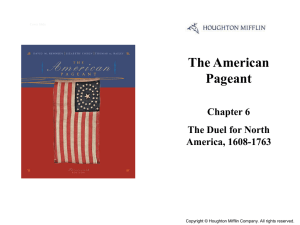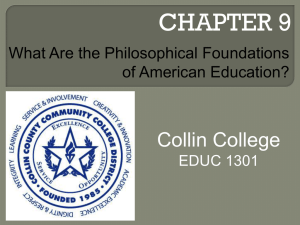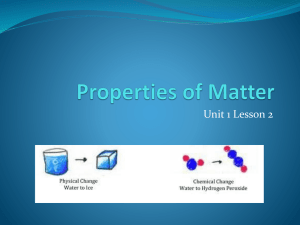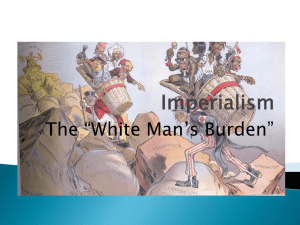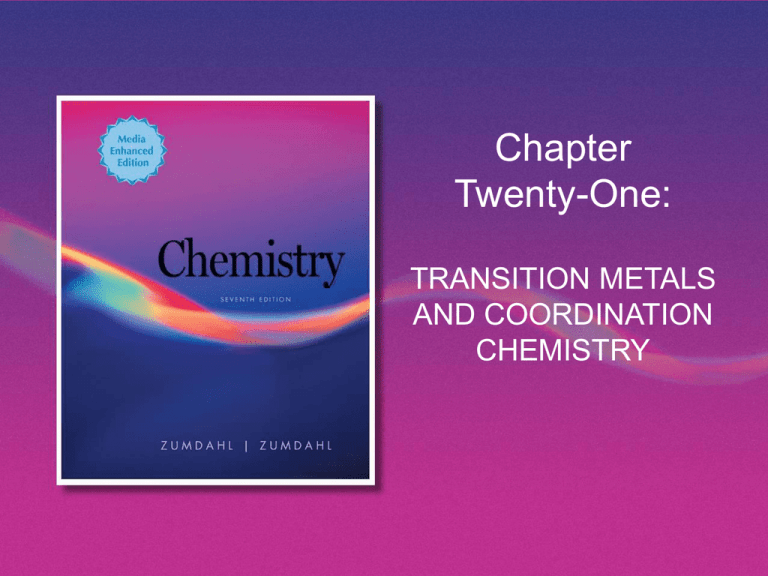
Chapter
Twenty-One:
TRANSITION METALS
AND COORDINATION
CHEMISTRY
Transition Metals
• Show great similarities within a given
period as well as within a given vertical
group.
21.1
Chapter 21 | Slide 2
Copyright © Houghton Mifflin Company. All rights reserved.
The Position of the Transition Elements
on the Periodic Table
21.1
Chapter 21 | Slide 3
Copyright © Houghton Mifflin Company. All rights reserved.
Forming Ionic Compounds
• More than one oxidation state is often
found.
• Cations are often complex ions – species
where the transition metal ion is
surrounded by a certain number of
ligands (Lewis bases).
21.1
Chapter 21 | Slide 4
Copyright © Houghton Mifflin Company. All rights reserved.
The Complex Ion Co(NH3)63+
21.1
Chapter 21 | Slide 5
Copyright © Houghton Mifflin Company. All rights reserved.
Ionic Compounds with Transition Metals
• Most compounds are colored because
the transition metal ion in the complex ion
can absorb visible light of specific
wavelengths.
• Many compounds are paramagnetic.
21.1
Chapter 21 | Slide 6
Copyright © Houghton Mifflin Company. All rights reserved.
Electron Configurations
• Example
V: [Ar]4s23d3
• Exceptions: Cr and Cu
Cr: [Ar]4s13d5
Cu: [Ar]4s13d10
21.1
Chapter 21 | Slide 7
Copyright © Houghton Mifflin Company. All rights reserved.
Electron Configurations
• First-row transition metal ions do not have
4s electrons.
– Energy of the 3d orbitals is less than that of
the 4s orbital.
Ti: [Ar]4s23d2
Ti3+: [Ar]3d1
21.1
Chapter 21 | Slide 8
Copyright © Houghton Mifflin Company. All rights reserved.
Concept Check
• What is the expected electron configuration of
Sc+?
• Explain.
21.1
Chapter 21 | Slide 9
Copyright © Houghton Mifflin Company. All rights reserved.
Plots of the First (Red Dots) and Third (Blue
Dots) Ionization Energies for the First-Row
Transition Metals
21.1
Chapter 21 | Slide 10
Copyright © Houghton Mifflin Company. All rights reserved.
Atomic Radii of the 3d, 4d, and 5d
Transition Series
21.1
Chapter 21 | Slide 11
Copyright © Houghton Mifflin Company. All rights reserved.
Oxidation States and Species for
Vanadium in Aqueous Solution
21.2
Chapter 21 | Slide 12
Copyright © Houghton Mifflin Company. All rights reserved.
Typical Chromium Compounds
21.2
Chapter 21 | Slide 13
Copyright © Houghton Mifflin Company. All rights reserved.
Some Compounds of Manganese in Its
Most Common Oxidation States
21.2
Chapter 21 | Slide 14
Copyright © Houghton Mifflin Company. All rights reserved.
Typical
Compounds of
Iron
21.2
Chapter 21 | Slide 15
Copyright © Houghton Mifflin Company. All rights reserved.
Typical
Compounds
of Cobalt
21.2
Chapter 21 | Slide 16
Copyright © Houghton Mifflin Company. All rights reserved.
Typical
Compounds of
Nickel
21.2
Chapter 21 | Slide 17
Copyright © Houghton Mifflin Company. All rights reserved.
Typical Compounds of Copper
21.2
Chapter 21 | Slide 18
Copyright © Houghton Mifflin Company. All rights reserved.
Alloys Containing Copper
21.2
Chapter 21 | Slide 19
Copyright © Houghton Mifflin Company. All rights reserved.
A Coordination Compound
Typically consists of a complex ion and
counterions (anions or cations as needed
to produce a neutral compound):
[Co(NH3)5Cl]Cl2
[Fe(en)2(NO2)2]2SO4
K3Fe(CN)6
21.3
Chapter 21 | Slide 20
Copyright © Houghton Mifflin Company. All rights reserved.
Coordination Number
• Number of bonds formed between the
metal ion and the ligands in the complex
ion.
– 6 and 4 (most common)
– 2 and 8 (least common)
21.3
Chapter 21 | Slide 21
Copyright © Houghton Mifflin Company. All rights reserved.
Ligands
• Neutral molecule or ion having a lone
electron pair that can be used to form a
bond to a metal ion.
– Monodentate ligand
– Bidentate ligand (chelate)
– Polydentate ligand
21.3
Chapter 21 | Slide 22
Copyright © Houghton Mifflin Company. All rights reserved.
Coordinate Covalent Bond
• Bond resulting from the interaction
between a Lewis base (the ligand) and a
Lewis acid (the metal ion).
21.3
Chapter 21 | Slide 23
Copyright © Houghton Mifflin Company. All rights reserved.
The Bidentate
Ligand
Ethylenediamine
and the
Monodentate
Ligand Ammonia
21.3
Chapter 21 | Slide 24
Copyright © Houghton Mifflin Company. All rights reserved.
The
Coordination
of EDTA with a
2+ Metal Ion
Chapter 21 | Slide 25
Copyright © Houghton Mifflin Company. All rights reserved.
Naming Coordination Compounds
[Co(NH3)5Cl]Cl2
1. Cation is named before the anion.
“chloride” goes last
2. Ligands are named before the metal ion.
ammonia (ammine) and chlorine (chloro)
named before cobalt
21.3
Chapter 21 | Slide 26
Copyright © Houghton Mifflin Company. All rights reserved.
Naming Coordination Compounds
[Co(NH3)5Cl]Cl2
3. For negatively charged ligands, an “o” is
added to the root name of an anion (such as
fluoro, bromo, etc.).
4. The prefixes mono-, di-, tri-, etc., are used to
denote the number of simple ligands.
penta ammine
21.3
Chapter 21 | Slide 27
Copyright © Houghton Mifflin Company. All rights reserved.
Naming Coordination Compounds
[Co(NH3)5Cl]Cl2
5. The oxidation state of the central metal ion is
designated by a Roman numeral:
cobalt (III)
6. When more than one type of ligand is
present, they are named alphabetically:
pentaamminechloro
21.3
Chapter 21 | Slide 28
Copyright © Houghton Mifflin Company. All rights reserved.
Naming Coordination Compounds
[Co(NH3)5Cl]Cl2
7. If the complex ion has a negative charge, the
suffix “ate” is added to the name of the metal.
The correct name is:
pentaamminechlorocobalt (III) chloride
21.3
Chapter 21 | Slide 29
Copyright © Houghton Mifflin Company. All rights reserved.
Some Classes of Isomers
Chapter 21 | Slide 30
Copyright © Houghton Mifflin Company. All rights reserved.
Structural Isomerism
• Coordination Isomerism:
Composition of the complex ion varies
[Cr(NH3)5SO4]Br and [Cr(NH3)5Br]SO4
• Linkage Isomerism:
Composition of the complex ion is the same,
but the point of attachment of at least one of
the ligands differs.
21.4
Chapter 21 | Slide 31
Copyright © Houghton Mifflin Company. All rights reserved.
Linkage
Isomerism
of NO2-
Chapter 21 | Slide 32
Copyright © Houghton Mifflin Company. All rights reserved.
Stereoisomerism
• Geometrical Isomerism (cis-trans):
Atoms or groups of atoms can assume
different positions around a rigid ring or
bond.
Cis – same side (next to each other)
Trans – opposite sides (across from each
other)
21.4
Chapter 21 | Slide 33
Copyright © Houghton Mifflin Company. All rights reserved.
Geometrical
(cis-trans)
Isomerism for
a Square
Planar
Compound
Chapter 21 | Slide 34
Copyright © Houghton Mifflin Company. All rights reserved.
Geometrical (cis-trans) Isomerism for
an Octahedral Complex Ion
21.4
Chapter 21 | Slide 35
Copyright © Houghton Mifflin Company. All rights reserved.
Stereoisomerism
• Optical Isomerism:
– Isomers have opposite effects on planepolarized light
21.4
Chapter 21 | Slide 36
Copyright © Houghton Mifflin Company. All rights reserved.
Unpolarized Light Consists of Waves
Vibrating in Many Different Planes
21.4
Chapter 21 | Slide 37
Copyright © Houghton Mifflin Company. All rights reserved.
The Rotation of the Plane of Polarized
Light by an Optically Active Substance
21.4
Chapter 21 | Slide 38
Copyright © Houghton Mifflin Company. All rights reserved.
Optical Activity
• Exhibited by molecules that have
nonsuperimposable mirror images (chiral
molecules)
• Enantiomers – isomers of
nonsuperimposable mirror images
21.4
Chapter 21 | Slide 39
Copyright © Houghton Mifflin Company. All rights reserved.
A Human Hand Exhibits a
Nonsuperimposable Mirror Image
21.4
Chapter 21 | Slide 40
Copyright © Houghton Mifflin Company. All rights reserved.
Concept Check
• How many isomers of [Co(en)2Cl2]Cl are there?
• Draw them, and list the type of isomer.
21.4
Chapter 21 | Slide 41
Copyright © Houghton Mifflin Company. All rights reserved.
The Interaction Between a Metal Ion
and a Ligand Can Be Viewed as a
Lewis Acid-Base Reaction
21.5
Chapter 21 | Slide 42
Copyright © Houghton Mifflin Company. All rights reserved.
Hybrid Orbitals on Co3+ Can Accept an Electron
Pair from Each NH3 Ligand
21.5
Chapter 21 | Slide 43
Copyright © Houghton Mifflin Company. All rights reserved.
The Hybrid Orbitals Required for
Tetrahedral, Square Planar, and Linear
Complex Ions
21.5
Chapter 21 | Slide 44
Copyright © Houghton Mifflin Company. All rights reserved.
Crystal Field Model
Focuses on the energies of the d orbitals
Assumptions
1. Ligands are negative point charges
2. Metal-ligand bonding is entirely ionic:
• strong-field (low-spin):
large splitting of d orbitals
• weak-field (high-spin):
small splitting of d orbitals
21.6
Chapter 21 | Slide 45
Copyright © Houghton Mifflin Company. All rights reserved.
An Octahedral Arrangement of Point-Charge
Ligands and the Orientation of the 3d
Orbitals
21.6
Chapter 21 | Slide 46
Copyright © Houghton Mifflin Company. All rights reserved.
The Energies of the 3d Orbitals for a
Metal Ion in an Octahedral Complex
21.6
Chapter 21 | Slide 47
Copyright © Houghton Mifflin Company. All rights reserved.
Possible
Electron
Arrangements
in the Split 3d
Orbitals in an
Octahedral
Complex of
Co3+
Chapter 21 | Slide 48
Copyright © Houghton Mifflin Company. All rights reserved.
Magnetic Properties
• Strong-field (low-spin):
– Yields the minimum number of unpaired
electrons.
• Weak-field (high-spin):
– Gives the maximum number of unpaired
electrons.
• Hund’s rule still applies.
21.6
Chapter 21 | Slide 49
Copyright © Houghton Mifflin Company. All rights reserved.
Spectrochemical Series
• Strong-field ligands to weak-field ligands
(large split)
(small split)
CN– > NO2– > en > NH3 > H2O > OH– > F– > Cl– > Br– > I–
• Magnitude of split for a given ligand
increases as the charge on the metal ion
increases.
21.6
Chapter 21 | Slide 50
Copyright © Houghton Mifflin Company. All rights reserved.
Complex Ion Colors
• When a substance absorbs certain
wavelengths of light in the visible region,
the color of the substance is determined
by the wavelengths of visible light that
remain.
– Substance exhibits the color complementary
to those absorbed
21.6
Chapter 21 | Slide 51
Copyright © Houghton Mifflin Company. All rights reserved.
Complex Ion Colors
• The ligands coordinated to a given metal
ion determine the size of the d-orbital
splitting, thus the color changes as the
ligands are changed.
• A change in splitting means a change in
the wavelength of light needed to
transfer electrons between the t2g and eg
orbitals.
21.6
Chapter 21 | Slide 52
Copyright © Houghton Mifflin Company. All rights reserved.
Absorbtion of Visible Light by the
Complex Ion Ti(H2O)63+
21.6
Chapter 21 | Slide 53
Copyright © Houghton Mifflin Company. All rights reserved.
Concept Check
• Which of the following are expected to form
colorless octahedral compounds?
Cu+
Zn2+
Fe2+
Mn2+
Cr3+
Ti4+
Ag+
Fe3+
Cu2+
Ni2+
21.6
Chapter 21 | Slide 54
Copyright © Houghton Mifflin Company. All rights reserved.
Tetrahedral Arrangement
• None of the 3d orbitals “point at the
ligands”.
– Difference in energy between the split d
orbitals is significantly less
• d-orbital splitting will be opposite to that
for the octahedral arrangement.
– Weak-field case (high-spin) always applies
21.6
Chapter 21 | Slide 55
Copyright © Houghton Mifflin Company. All rights reserved.
The d Orbitals in a Tetrahedral
Arrangement of Point Charges
21.6
Chapter 21 | Slide 56
Copyright © Houghton Mifflin Company. All rights reserved.
The Crystal Field Diagrams for
Octahedral and Tetrahedral Complexes
21.6
Chapter 21 | Slide 57
Copyright © Houghton Mifflin Company. All rights reserved.
Concept Check
• Consider the Crystal Field Model (CFM).
a) Which is lower in energy, d-orbital lobes
pointing toward ligands or between?
Why?
b) The electrons in the d-orbitals - are they
from the metal or the ligands?
21.6
Chapter 21 | Slide 58
Copyright © Houghton Mifflin Company. All rights reserved.
Concept Check Cont’d
• Consider the Crystal Field Model (CFM).
c) Why would electrons choose to pair up in
d-orbitals instead of being in separate orbitals?
d) Why is the predicted splitting in
tetrahedral complexes smaller than in
octahedral complexes?
21.6
Chapter 21 | Slide 59
Copyright © Houghton Mifflin Company. All rights reserved.
Concept Check
• Using the Crystal Field Model, sketch possible
electron arrangements for the following. Label
each as strong or weak field.
a) Ni(NH3)62+
b) Fe(CN)63c) Co(NH3)63+
21.6
Chapter 21 | Slide 60
Copyright © Houghton Mifflin Company. All rights reserved.
Concept Check
• A metal ion in a high-spin octahedral complex
has 2 more unpaired electrons than the same
ion does in a low-spin octahedral complex.
• What are some possible metal ions for which
this would be true?
21.6
Chapter 21 | Slide 61
Copyright © Houghton Mifflin Company. All rights reserved.
Concept Check
• Between [Mn(CN)6]3- and [Mn(CN)6]4- which is
more likely to be high spin? Why?
21.6
Chapter 21 | Slide 62
Copyright © Houghton Mifflin Company. All rights reserved.
The d Energy
Diagrams for
Square Planar
Complexes
21.6
Chapter 21 | Slide 63
Copyright © Houghton Mifflin Company. All rights reserved.
The d Energy
Diagrams for
Linear
Complexes
Where the
Ligands Lie
Along the z Axis
21.6
Chapter 21 | Slide 64
Copyright © Houghton Mifflin Company. All rights reserved.
Concept Check
• Sketch the d-orbital splitting for each of the
following cases, and explain your answer: A
linear complex with ligands on the:
a) X axis
b) Y axis
21.6
Chapter 21 | Slide 65
Copyright © Houghton Mifflin Company. All rights reserved.
Biological Importance of Iron
• Plays a central role in almost all living
cells.
• Component of hemoglobin and
myoglobin
• Involved in the electron-transport chain
21.7
Chapter 21 | Slide 66
Copyright © Houghton Mifflin Company. All rights reserved.
The Heme
Complex
Chapter 21 | Slide 67
Copyright © Houghton Mifflin Company. All rights reserved.
Myoglobin
Chapter 21 | Slide 68
Copyright © Houghton Mifflin Company. All rights reserved.
Hemoglobin
21.7
Chapter 21 | Slide 69
Copyright © Houghton Mifflin Company. All rights reserved.
Metallurgy
• Process of separating a metal from its
ore and preparing it for use.
• Steps:
– Mining
– Pretreatment of the ore
– Reduction to the free metal
– Purification of the metal (refining)
– Alloying
21.8
Chapter 21 | Slide 70
Copyright © Houghton Mifflin Company. All rights reserved.
The Blast
Furnace
Used In the
Production
of Iron
Chapter 21 | Slide 71
Copyright © Houghton Mifflin Company. All rights reserved.
A Schematic of the Open Hearth
Process for Steelmaking
21.8
Chapter 21 | Slide 72
Copyright © Houghton Mifflin Company. All rights reserved.
The Basic
Oxygen
Process for
Steelmaking
Chapter 21 | Slide 73
Copyright © Houghton Mifflin Company. All rights reserved.


